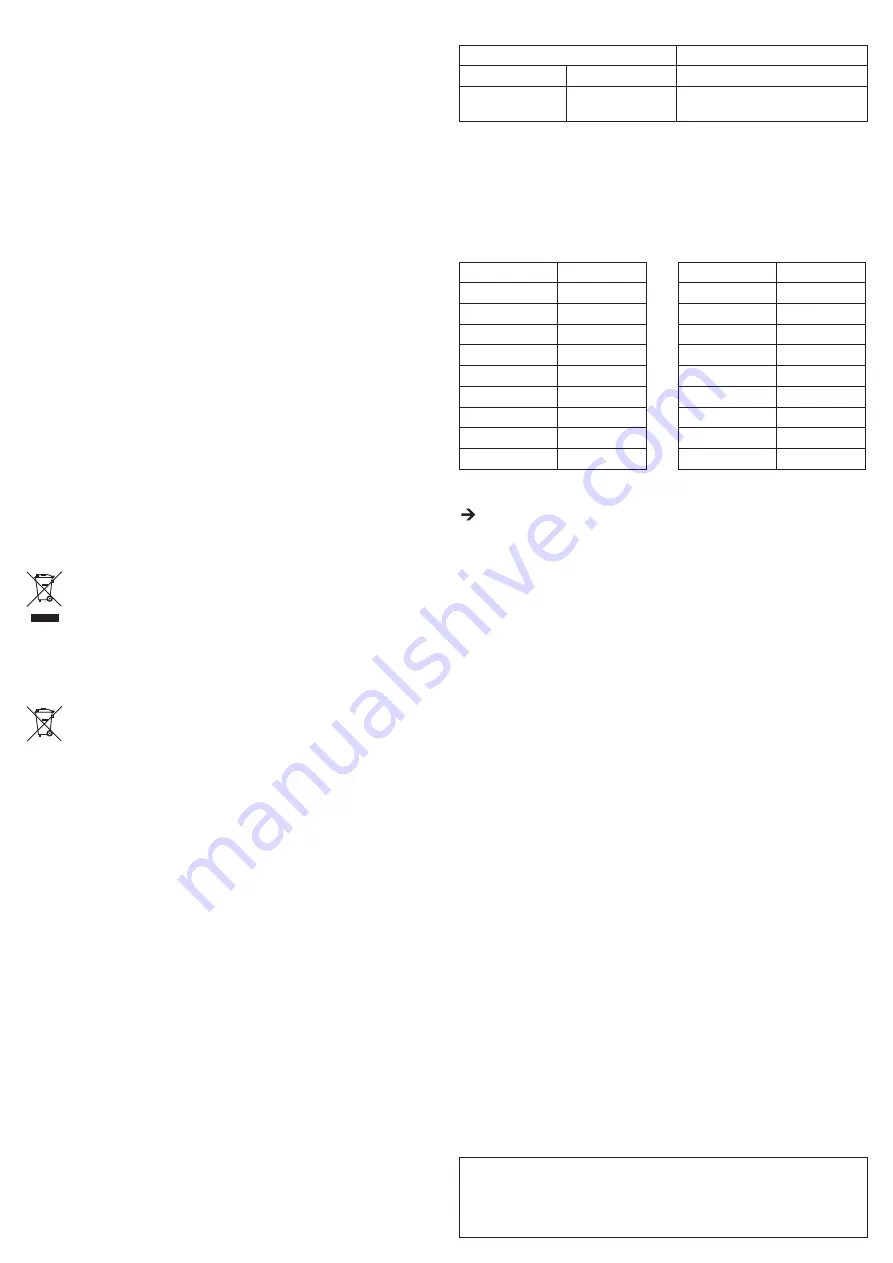
Legal notice
This is a publication by Conrad Electronic SE, Klaus-Conrad-Str. 1, D-92240 Hirschau (www.conrad.com).
All rights including translation reserved. Reproduction by any method, e.g. photocopy, microfilming, or the capture in electronic data
processing systems require the prior written approval by the editor. Reprinting, also in part, is prohibited. This publication represent the
technical status at the time of printing.
© Copyright 2014 by Conrad Electronic SE.
G
Accuracy (at ambient temperature of 23 °C +/- 3 °C, emission level 0.95):
Temperature measuring range
Accuracy
-60 to 0 °C
-76 to +32 °F
± 2,86 °C/± 5,15 °F (+0,07/°C)
>0 to +550 °C
>+32 to +1022 °F
± 2,86% of the measured value or
± 2,86 °C/5,15 °F
Emission level of different surfaces
The emission levels listed in the table are approximate values. Different parameters such as
geometry and the surface quality can affect the emission level of an object.
The emission level can be set on the measuring instrument, depending on the application.
However, please note that the IR measuring method is suitable for bare metals only to a
limited extent and requires a special surface treatment (e.g. matte insulation tape etc.).
Surface
Emission level
Surface
Emission level
Aluminium, bare
0.04
Varnish, matte
0.97
Asphalt
0.90 - 0.98
Foodstuffs
0.93 - 0.98
Concrete
0.94
Human skin
0.98
Ice
0.96 - 0.98
Plastic
0.94
Ferric oxide
0.78 - 0.82
Paper
0.97
Hard plaster
0.80 - 0.90
Sand
0.90
Glass/porcelain
0.92 - 0.94
Textiles
0.90
Rubber, black
0.94
Water
0.92 - 0.96
Wood
0.94
Bricks, plastering
0.93 - 0.96
You can order matching replacement batteries stating the order no. 65 23 03.
Please order 2 times.
7. CLEANING AND MAINTENANCE
Apart from occasional cleaning and battery replacement, the device requires no servicing.
Always observe the following safety instructions before cleaning the device:
a) Cleaning of the lens
Remove loose particles with clean compressed air and wipe off remaining residues with a
fine lens brush. Clean the surface with a lens cleaning cloth or a clean, soft, lint-free cloth.
To remove fingerprints and other fat residues, the cloth can be moistened with water or lens
cleaning solution. Do not use any acidic, alcoholic or other solvents or rough, linty cloth to
clean the lens. Avoid applying too much pressure during cleaning.
b) Cleaning the housing
Do not use scouring, chemical or aggressive cleaning agents such as benzene, alcohol or
similar chemicals. These might attack the surface of the device. Furthermore, the fumes are
hazardous to your health and are explosive. Moreover, you should not use sharp-edged tools,
screwdrivers or metal brushes or similar implements for cleaning.
For cleaning the device or the display and the measuring cables, use a clean, slightly damp,
fuzz-free, antistatic cloth.
c) Error messages
To ensure the reliability of the measuring device, various protective functions are integrated. If
the measuring device detects an error, the error is indicated as error code.
The following error codes are possible:
Er2
The ambient temperature has changed quickly (warm room -> cold room). Wait
for at least 30 minutes to allow the measuring instrument to reach ambient
temperature. Observe the operating temperature!
Er3
The operating temperature range has been exceeded. Observe the information
for the operating temperature in the technical data.
Er5 - Er9 System error. The measuring instrument must be reset. Remove the batteries and
leave the device switched off without batteries for at least 1 minute. Replace the
batteries. The device should now function again. If this is not the case, contact our
service department.
8. DISPOSAL
a) Product
Electronic devices are recyclable material and do not belong in the household
waste.
Please dispose of the product, when it is no longer of use, according to the current
statutory requirements. Remove any battery/rechargeable batteries inserted and
dispose of them separately from the product.
b) Batteries and rechargeable batteries
As the end user, you are required by law (Battery Ordinance) to return all spent batteries/
rechargeable batteries; disposal of them in the household waste is prohibited.
Batteries/rechargeable batteries contain harmful materials and are labelled with the
symbol shown to indicate that disposal in the household waste is forbidden. The
symbols of the relevant heavy metals are: Cd=cadmium, Hg=mercury, Pb=lead
(marking can be seen on the battery/rechargeable battery, e.g. underneath the
refuse bin symbol shown on the left).
You can return your used batteries/rechargeable batteries free of charge at the official col-
lection points of your community, in our stores, or at places where batteries or rechargeable
batteries are sold.
You thereby fulfil your statutory obligations and contribute to the protection of the environ-
ment.
9. TECHNICAL DATA
Response time ......................................< 1 s
IR spectrum ..........................................8 - 14 μm
Emission level .......................................0.1 - 1.0 (0.95 preset)
Resolution .............................................0.1 °C
IR measurement optics .........................12:1
Laser: Rated power ..............................< 1 mW, laser class 2, wave length 630 - 680 nm
Operating temperature .........................0 to +50 °C
Operating humidity ...............................10 to 90 % rel. humidity
Storage temperature .............................-10 to +60 °C
Storage humidity ...................................< 80 % rel. humidity
Protection class ....................................IP54
Operating voltage .................................3 V/DC (2 Micro-batteries AAA/LR03)
Weight ..................................................175 g
Dimensions (W x H x D) .......................41 x 145 x 80 mm












